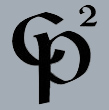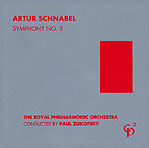
SYMPHONY NO. 2
THE ROYAL PHILHARMONIC ORCHESTRA
PAUL ZUKOFSKY, conductor

 |
ARTUR SCHNABEL SYMPHONY NO. 2 THE ROYAL PHILHARMONIC ORCHESTRA PAUL ZUKOFSKY, conductor |
 |
Artur Schnabel (1882-1951) wrote his Second Symphony in the summers of 1941, 42 and 43 while on "vacation" in the mountains of New Mexico. The work is scored for three each of flutes, oboes, clarinets, and bassoons; four horns; three each of trumpets and trombones; tuba; timpani, and percussion, including a keyboard glockenspiel; harp; and strings. The work is in four movements, of which the last two are concatenated. Of Schnabel's three symphonies, I find this one the least complex, the First being much denser harmonically (Schnabel was most definitely not a twelve-tone composer, although he did use all twelve tones!), while the Third is much more difficult rhythmically, foreshadowing later usage and developments that are to be found in, for example, an Elliott Carter. Structurally, Schnabel's Second Symphony is akin to his Violin and Piano Sonata of 1935 (re-released on compact disc as CP2102), and in that sense is a retreat from the earlier, free-form adventures, of the 1919 Solo Violin Sonata (re-released on CP2106). This is not to be understood as a capitulation to conventionality. The phrase-length succession is still extremely free, to the extent that it is almost more of a surprise to find consecutive phrases of the same length, than it is to find those of contrasting lengths. The orchestration is also remarkable, using many unusual instrumental "doublings" that change constantly, so that when conducting this work, one has an impression of timbral manipulation that is far closer to what one finds in an electronic music studio, than to "orchestration" as we may be used to, and the complexity of the articulation, and its notation, reinforce that impression. To me, Schnabel's approach to orchestration appears closer to that of Milton Babbitt's, than to that of Roger Sessions'1 (although Babbitt's notation for articulation is far more restricted than Schnabel's). In any event, the changing "doublings" result in a constant color metamorphosis ahead of its time stylistically, as much of Schnabel's music was, and thereby hangs a tale. Saerchinger's hagiography of Schnabel contains two short articles on Schnabel's compositions, one by Ernst Krenek, the other by Roger Sessions. I have always been puzzled by aspects of Krenek's article as, while it is clear that Krenek admires, respects, and perhaps enjoys Schnabel's music, he also states that it was "difficult for Schnabel to embrace wholeheartedly the controversial phenomena of a problematic present, to which he after all belonged. Hence came his aversion for any kind of musical 'theory'." Some of Krenek's carping is explainable as that of an old, old, friend who, as family is wont to do, insists on pointing out character flaws for the purported betterment of the pointee!; some can be assigned to the voice of a theorist with a gift for very clear presentation, protesting against someone who might have been more forthcoming on the value of theory. Some of the objections are assignable to Krenek's upset at the fact that Schnabel stayed out of (what turned out to be) the meaningless battles of the 12-tone composers versus "the others"—meaningless because the primary concern about the 12-tone system was the potential loss of compositional individuality, a concern dismissed by history once Stravinsky, Copland, Sessions, Babbitt, Boulez, et al, wrote 12-tone music, and remained identifiable as themselves (why a comparison between Schoenberg, Berg and Webern was not sufficient to prove that the 12-tone system was a neutral system like any other is one of the great mysteries). Nevertheless, there remains a residual misunderstanding of Schnabel-the-composer's place in history. Other than for his very early music (pre 1914) Schnabel was always on the border of some compositional frontier, without ever crossing the line into fadism (note, however, that Busoni, in a letter dated March 31, 1918, basing his judgment on someone else's description of the music, states that either of Schnabel's first String Quartet, or the aforementioned Solo Violin Sonata, belongs in the musical category of Futurist experiment², conveniently forgetting some of his own music, such as the Sonatina Seconda for piano of 1912). I am not implying that Schnabel cared whether he was on a frontier, or that he made a conscious decision to be there. He was just simply there, through no fault of his own! History is a messy business. We believe in heroes that appear suddenly with solutions, but in actuality, such types have always built upon the work of many others. Far more usual of the forward-moving drift, with its internal Brownian motion of competing objectives, is the case where "things are in the air," and people unbeknown to one another, suddenly, and simultaneously, begin to explore, invent, and develop similar ideas. Of some of those ideas that were "in the air," and that I feel Schnabel's music partakes of, I could point to the problems of: how to relate (and notate) musics at different tempi, (this led to metric modulation); how to control quick changing timbres, and invent new ones, (this led to electronic music studios, computer generated, and synthesized sound); how to relate and cohere simultaneously occurring different kinds of musics that were not "leit-motif" based, (very partially this led to "serialism," but also to exploration of spatial constraints); and how to convey all these, first to a performer, but ultimately to a receiver (this led first to an explosion in the complexity and detail of notation, and ultimately to graphic and/or proportional notation, as well as the formal allowance of alleatory, such as used by Berio). I doubt that Schnabel was consciously aware of any of these budding trends, and I don't think it maters whether he was or was not. Hindsight allows us to better determine what did, and did not, "belong," and, viewed in this manner, I believe that in his works dating from 1935, not only was Schnabel NOT avoiding "the controversial phenomena of a problematic present" but, whether he knew it or not, was part and parcel of a ground-swell of music that was to erupt within a few years of his death. In so doing, Schnabel remained true to that exploratory self so clearly revealed in the works dating from 1914, especially the Notturno, the Solo Violin Sonata, and the String Quartets. It is because of Schnabel's prescience, as well as the undoubted beauty of the music, that Roger Sessions said "The more one studies these scores, the more indisputable one finds their evidences of authentic genius, and the more captivated one remains."1 PZ, May, 1991
|
||||||||||||||||